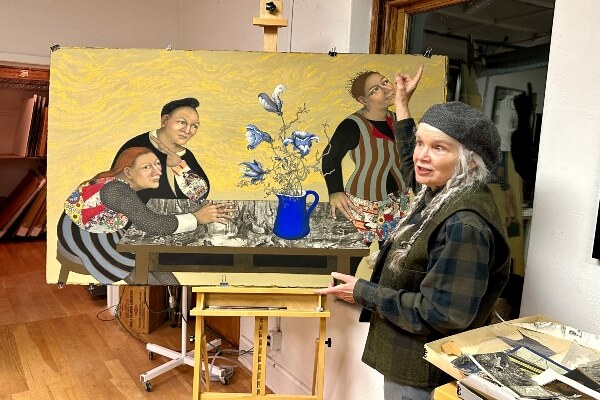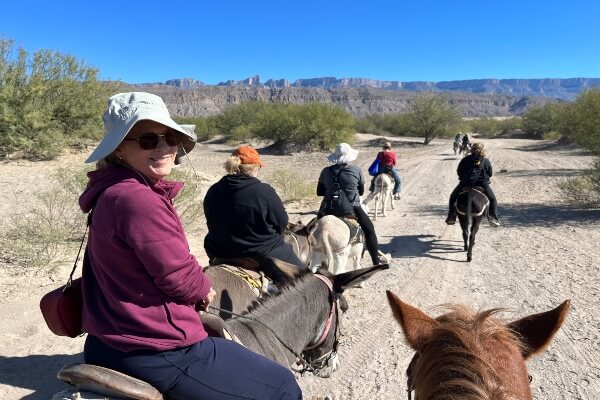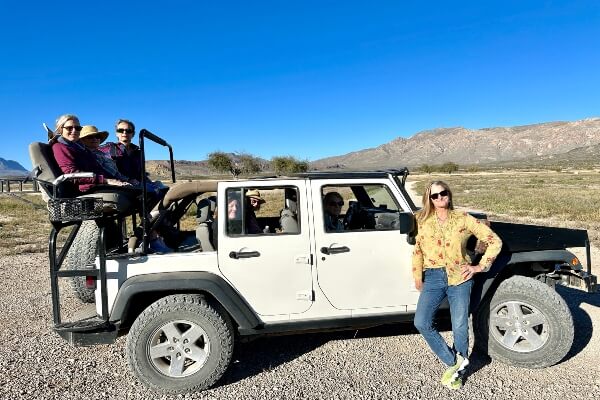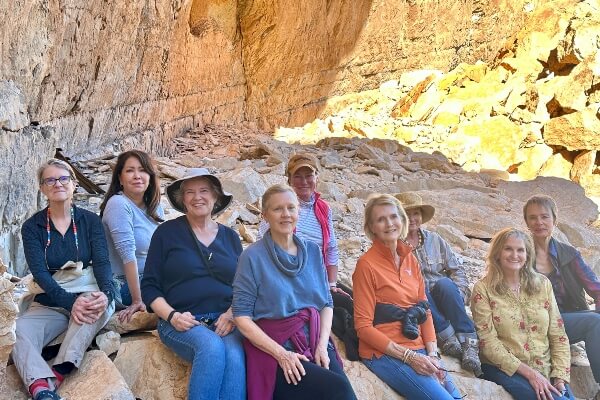Marfa and Big Bend National Park may not be the first destinations that come to mind when you think of great food, unconventional art, captivating scenery, but they should be.
NextTribe is bringing a small group of women to Marfa and Big Bend National Park this coming December. Want to join us? All the details here.
It takes a long time to get to West Texas from Austin, but the way NextTribe travels, it feels like a road trip with your best girlfriends. Getting there is half the fun. On the way out to Marfa, with NextTribe founder Jeannie Ralston at the wheel, we played music, told stories, and got to know each other: a world class photographer from New York, a Chicago attorney and her sister, a prominent talent recruiter, a former child actor (remember “The Waltons”?) and other women with equally interesting life stories.
Read more: How 12 Women Found Art, Awe and Adventure in Big Bend
Marfa: Immersing Ourselves in Art

By the time we got to the Paisano Hotel in Marfa, the 12 of us were joking with each other as if we’d been pals for years. Listed on the National Register of Historic Places, the Paisano was built in 1929 and recently renovated. The Elizabeth Taylor suite is named after the actress who stayed in that very room during the filming of “Giant” in Marfa; the whole cast, including James Dean and Rock Hudson, took over the hotel, which now displays an impressive collection of memorabilia from the film in the lobby.
Refreshed and ready to go, we all climbed back into the Sprinter van to visit Julie Speed in her art studio, where we enjoyed wine and hors d’oeuvres.
After dropping out of Rhode Island School of Design at 19, Julie traveled the country and ended up in Marfa in 1978, where she started teaching herself to paint.
Her journey to full-time art was circuitous and inspiring. The elfin Speed, who wears her hair in three braids, topped off with a cap, told us about her early life in the backwoods of Canada. One day, a Royal Canadian Mounted Police (a.k.a. Dudley Do-Right to most Americans our age) knocked on the door to deliver a message. The Austin-based band, “The Fabulous Thunderbirds” was looking for her husband, an accomplished drummer.
I asked why the Mounties were involved in such a strange transaction. “Well, we didn’t have a phone.” Obviously! I told her I saw “The Fabulous Thunderbirds” on New Year’s Eve, 1986—my first year in Austin. Her husband must have been the drummer. She smiled. “Yeah, that was a pretty good show!”
Seeing art in a gallery is one thing: Hearing an artist talk about her life and her artistic process in the comfort of her studio is so much more satisfying.
Speed, who lives with her husband in a compound near the famous Chinati Foundation (founded by artist Donald Judd), went on to talk about her work, and how she enjoys experimenting with collage, gouaches, drawing, and oil painting. Seeing art in a gallery is one thing: Hearing an artist talk about her life and her artistic process in the comfort of her studio, surrounded by other women, is so much more satisfying.
After two nights at the Paisano, which included a trip to see the Prada Store installation art and a night-time Marfa Lights experience, we packed up and headed toward the Rio Grande River and the southern border. This part of Texas is drastically different from the images we see on the news. No walls, no barbed wire, no agents with guns; just natural beauty as it has been for millennia.
Big Bend, Here We Come!
On the way to Big Bend, we stopped in the border town of Presidio. A local bakery owner wanted to know what we were all doing out there at his end of the earth and was surprised when we told him we were a small group of women from across the country who’d come to plug into art and nature.
We met Charlie Angell, a friend of Jeannie’s who guides expeditions along the Rio Grande and throughout the Big Bend area. He has renovated a historic church, which he’s turned into an Airbnb. He also hosts seasonal trail guides like Maddie, who would guide one of our hikes later in the week. The decor was a tribute to Hollywood, kind of a funky vibe for a place where early West Texas settlers used to come and pray.
In Big Bend, the colors, light and shadow are constantly changing. There’s nothing like it for nature lovers.
We stopped for lunch at a beautiful country club in the desert, the perfect place to catch the highlights of the UT football game and enjoy a cold drink.
Back in the van, we headed to the Chisos Mountain Lodge in Big Bend National Park, and a short hike before dinner. Built in 1964, the old lodge will be torn down this year to make way for a new (and probably fancier) lodge and restaurant. This remote gem is the only lodging in the park and is always booked a year in advance. We all considered ourselves fortunate to be among the last guests to stay there before it’s modernized.
I had a memorable camping experience in Big Bend with friends in 1988. Back then, you could wade across a shallow part of the Rio Grande to get to the small Mexican town of Boquillas. On this trip, we had to show our passports each way, which was a minor inconvenience and kind of cool. The border station is managed by a lone, friendly officer who reminded us to get back before he closed or we could enjoy a nice night in Mexico!
Crossing the Border

We walked down a short hill to the river, spotting a roadrunner near the path, and met a few locals who pulled us across in a rowboat. On the other side, some of us walked, and some rode up the hill on horses or donkeys to have lunch at Jose Falcon’s, an open-air cantina with a patio and a higher view of the river and the bluffs on either side.
In Boquillas, Mexico, a local guitarist serenaded us as we enjoyed our midday meal, cervezas and margaritas.
A local guitarist serenaded us as we enjoyed our midday meal and our cervezas and margaritas. The mournful ballads he sang made me wonder about his life: Had he gone to war, seen the world? Had he lived in Boquillas all his life?
With tourism as its economic lifeline, Boquillas is little more than an oasis in the desert. It’s hard to imagine how they survived the pandemic when the border was closed and the nearest Mexican city was five hours away. Big Bend National Park, bordering the State Park by the same name, is massive: 1,252 square miles. You can drive for hours surrounded by rock formations, prickly pear cactus and ocotillo, a spiny shrub. The colors, light and shadow are constantly changing, depending on the time of day and position of the sun. For lovers of nature, there’s nothing like this vast, remote, uninhabited wilderness.
Maybe I’ve seen too many old Westerns, but I couldn’t help imagining Comanches on horseback on this land. They lived here and protected this land for centuries. I bought a book in the national park’s gift shop called Empire of the Summer Moon, which tells the story of the Western frontier. A fellow NextTriber told me about it, and I recommend it to anyone interested in West Texas or American or Native American history.
Getting a Taste of Texas Ranch Life

On our way to Marathon, on our last full day, we turned off the highway and took a dusty side road that led through 10 miles of desert plants and wildlife. Jeannie was taking us to the 66,000-acre ranch owned by her friend, retired oilman J.P. Bryan.
We learned that the town of Bryan (near College Station, the home of Texas A&M) is named for his family. I’ve since learned that J.P. is also a descendent of Stephen F. Austin, known as “the Father of Texas.” Deep roots and a love for the state are evident in all of J.P.’s endeavors.
When we arrived at the ranch compound, I was amazed at the beauty all around us. We ate a box lunch in the shady backyard of his spectacular ranch house which is run totally on solar power. There are no power lines on the ranch, which would really have been a distraction from the natural beauty of the landscape.
Among the astounding features of J.P.’s ranch are the ancient petroglyphs left by the people who lived on this land some 9,000 years ago. To see the drawings on the rock walls, you have to climb up a steep hill, to a flat, protected area where the original inhabitants made their home.
Among the ranch’s most astounding features are the ancient petroglyphs left by people who lived on the land some 9,000 years ago.
Some of us stayed below, not wanting to make the hike, but we were not disappointed by our time downhill. The ranch manager, Chris remained with us and entertained us with stories of his life, including his acting career in New York City.
Later, we took turns riding with Chris in a safari-style open jeep, while others followed in the Sprinter. As we rode around the ranch, we saw three beautiful stags with full racks and a couple of javelinas, among other creatures.
When we returned to the ranch house, we met J.P. Bryan, who was happy to show us the pool with the retractable cover and the upper terrace where he said he and his wife lie out under the stars at night. I imagined what a lovely experience that would be, so far from any light pollution.
Celebrating New Friendships on the Back Roads

Instead of staying to stargaze at the ranch, we headed about an hour north to the town of Marathon, TX, population 365, where we got to see more of J.P. Bryan’s empire. The Gage Hotel was built in the 1920’s by the same architect responsible for the Paisano in Marfa and other hotels in this part of the world. Bryan bought it in the 1970s for $25,000, and when it first opened “we could have put a bed in the middle of the road and nobody would have slept there.” The renovation of the hotel and two nearby restaurants has brought a lot of attention to Marathon, and it’s now a sought-after wedding destination.
I thought it was amazing that even though the two places couldn’t be more different, the chance to make fast friends was exactly the same.
We celebrated the end of our trip at the hotel’s White Buffalo Bar and ran into Chris again. Not too surprising as there are not many other places to eat in Marathon!
Our ride back to Austin was filled with chatter and laughter about all that we had experienced together. I had traveled to Paris with NextTribe six months earlier and had created deep connections on that trip as well. I thought it was amazing that even though the two places couldn’t be more different, the chance to make fast friends was exactly the same.
Paris certainly has its charm and I will go there again, but the West Texas desert has captured a piece of my heart.
Read More: These Packing Tips Are a Game-Changer
Photo credit (top and bottom images): Cheryl Klauss




















0 Comments